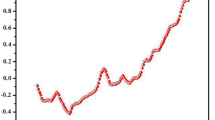Abstract
This study was carried out in a factory producing multiwalled carbon nanotubes (MWCNTs) by the catalytic chemical vapor deposition method in a pyrolysis reactor. Air samples of the personal breathing areas were collected simultaneously on mixed cellulose ester filters, for analysis by transmission electron s (TEM), and on high-purity quartz filters for thermal-optical analysis of elemental carbon (EC). It is found that the production of MWCNTs is accompanied by the release of the MWCNT structures in the air of different working zones. The concentration of respirable aerosol in the personal breathing areas, averaged over an 8-hour period, ranges from 0.54 to 6.11 μg/m3 based on EC. Airborne MWCNTs were found in the form of agglomerates that range in size from about 1 to 10 μm. These data are consistent with measurements in different plants by two other international groups (from the United States and Sweden) using similar methodology (TEM in combination with EC analysis). In the absence of convincing data on the potential health risks of MWCNTs, and following the principle of reasonable precautions, preventive measures should be taken to minimize exposure to these materials.
Similar content being viewed by others
References
NIOSH. “Occupational exposure to carbon nanotubes and nanofibers,” NIOSH Current Intelligence Bulletin No. 65. http://www.cdc.gov/niosh/docs/2013-145/pdfs/ 2013-145.pdf. Cited June 6, 2015.
P. A. Baron, A. D. Maynard, and M. Foley, “Evaluation of aerosol release during the handling of unrefined single walled carbon nanotubes material,” Report NIOSH DART-02-191 (Natl. Inst. Occupational Safety and Health, 2002).
G. Joseph, “Industrial hygiene air monitoring report,” DuPont Co. Internal Report (2002).
A. D. Maynard, P. A. Baron, M. Foley, et al. “Exposure to carbon nanotube material: Aerosol release during the handling of unrefined single-walled carbon nanotube material,” J. Toxicol. Environ. Health A 67, 87–107 (2004).
M. E. Birch, D. E. Evans, M. M. Methner, R. E. McCleery, K. G. Crouch, B.-K. Ku, M. D. Hoover, “Workplace assessment of potential exposure to carbonaceous nanomaterials,” Proceedings of the Seventh International Aerosol Conference, September 10–15, St. Paul, MN (2006).
M. M. Methner, M. E. Birch, D. E. Evans, et al., “Identification and characterization of potential sources of worker exposure to carbon nanofibers during polymer composite laboratory operations,” J. Occup. Environ. Hyg. 4, D125–130 (2007).
J. H. Han, E. J. Lee, J. H. Lee, et al.. “Monitoring multiwalled carbon nanotube exposure in carbon nanotube research facility,” Inhal. Toxicol. 20, 741–749 (2008).
D. E. Evans, B. K. Ku, M. E. Birch, K. H. Dunn. “Aerosol characterization during carbon nanofiber production: mobile direct-reading sampling,” Ann. Occup. Hyg. 54 (5), 514–531 (2010).
B. G. Lee, J. H. Lee, J. S. Yang, et al. “Exposure assessment of carbon nanotube manufacturing workplaces,” Inhal Toxicol. 22, 369–381 (2010).
J. Pauluhn. “Multi-walled carbon nanotubes (Baytubes): approach for derivation of occupational exposure limit.,” Regul. Toxicol. Pharmacol. 57, 78–89 (2010).
M. M. Methner, L. Hodson, and C. Geraci. “Nanoparticle emission assessment technique (NEAT) for the identification and measurement of potential inhalation exposure to engineered nanomaterials: Part B. Results from 12 field studies,” J. Occup. Environ. Hyg. 7, 163–176 (2010).
M. E. Birch., B. K. Ku, D. E. Evans, T. Ruda-Eberenz. “Exposure and emissions monitoring during carbon nanofiber production. Part I: elemental carbon and iron-soot aerosols,” Ann. Occup. Hyg. 55 (9), 1016–1036 (2011).
M. E. Birch. “Exposure and emissions monitoring during carbon nanofiber production. Part II: polycyclic aromatic hydrocarbons,” Ann. Occup. Hyg. 55 (9), 1037–1047 (2011).
M. Methner, C. Beaucham, C. Crawford, L. Hodson, and C. Geraci. “Field application of the nanoparticle emission assessment technique (NEAT): task-based air monitoring during the processing of engineered nanomaterials (ENM) at four facilities,” J. Occupat. Environ. Hyg. 9, 543–555 (2012).
M. M. Dahm, D. E. Evans, M. K. Schubauer-Berigan, M. E. Birch, and J. A. Deddens. “Occupational exposure assessment in carbon nanotube and nanofiber primary and secondary manufacturers: mobile directreading sampling,” Ann. Occup. Hyg. 57, 328–344 (2013).
M. Hedmer, C. Isaxon, P. T. Nilsson, et al. “Exposure and emission measurements during production, purification, and functionalization of arc-discharge-produced multi-walled carbon nanotubes,” Ann. Occup. Hyg. 58, 355–379 (2014).
M. M. Dahm, M. K. Schubauer-Berigan, D. E. Evans, et al., “Carbon nanotube and nanofiber exposure assessments: an analysis of 14 site visits,” Ann. Occup. Hyg. (2015). http://annhygoxfordjournalsorg/cgi/ pmidlookup?view=long&pmid=25851309. Cited June 11, 2015.
M. E. Birch. “Occupational monitoring of particulate diesel exhaust by NIOSH method 5040,” Appl. Occup. Environ. Hyg. 17, 400–405 (2002).
M. E. Birch, National Institute for Occupational Safety and Health, Cincinnati, OH, personal communication, January 2016.
“Using of quantitative determination methods of nanomaterials on nanoindustry factories” MR 1.2.2639-10 (2010). Available from GARANT legal referense system. [in Russian]
A. M. Cassell, J. A. Raymakers, J. Kong, and H. J. Dai. “Large scale CVD synthesis of single walled carbon nanotubes,” J. Phys. Chem. B 103, 6484 (1999).
I. G. William and R. A. Dewar. “Flame ionization detector for gas chromatography,” Nature 181 (4611), 760 (1958).
Author information
Authors and Affiliations
Corresponding author
Additional information
Original Russian Text © L.M. Fatkhutdinova, T.O. Khaliullin, R.R. Zalyalov, A.G. Tkachev, M.E. Birch, A.A. Shvedova, 2016, published in Rossiiskie Nanotekhnologii, 2016, Vol. 11, Nos. 1–2.
Rights and permissions
About this article
Cite this article
Fatkhutdinova, L.M., Khaliullin, T.O., Zalyalov, R.R. et al. Assessment of airborn multiwalled carbon nanotubes in a manufactoring environment. Nanotechnol Russia 11, 110–116 (2016). https://doi.org/10.1134/S1995078016010055
Received:
Accepted:
Published:
Issue Date:
DOI: https://doi.org/10.1134/S1995078016010055




